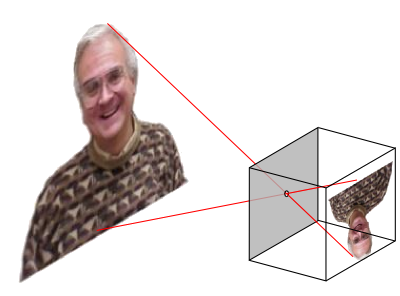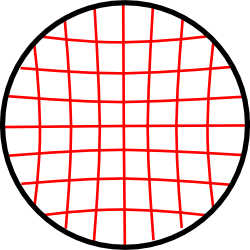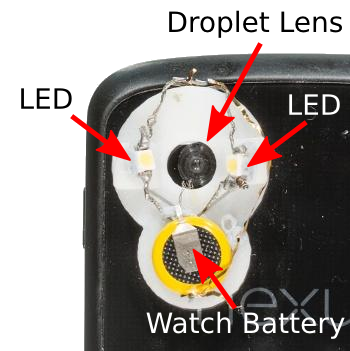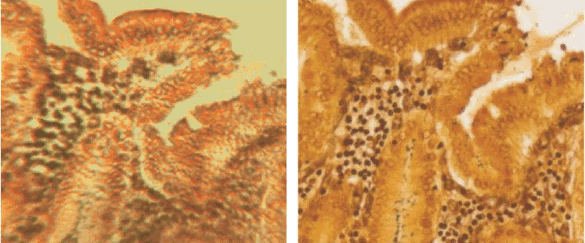Droplet Lens
May 7, 2014
Nearly every
physicist has constructed a
pinhole camera in their youth. It's one
experiment that requires no
monetary outlay, since
paper and
mother's sewing pins are always at hand. This device, also called a
camera obscura, was supposedly known to the
Greek philosopher Aristotle (384 BC-322 BC). Pinhole
diffraction is described in Book XV, chapter 6, of his "
Problems," which may have been authored instead by
his followers.
In the
Problems, Aristotle expounds on how the image of the
Sun, projected through the
rectangular holes of a
wicker basket, still maintains its
circular shape in the image projected onto the ground. The
Problems is not among the books typically studied by
students of Aristotle, but it discusses many interesting questions.
One such question is "Why do all men,
barbarians and
Greeks alike, count up to 10 and not up to any other number...?"(Problems, Book XV, chap. 3)[1] Aristotle would have a low opinion of our
binary-counting ways; viz.,
One race among the Thracians alone of all men count in fours, because their memory, like that of children, cannot extend farther and they do not use a large number of anything." (Problems, Book XV, chap. 3)[1]

The simplest type of pinhole camera will invert the image.
(Illustration by the author, using GIMP.)
Just a little more expensive than a pinhole is the
ball lens, usually made in
ball mills, and typically used for
focusing light into
optical fibers. Ball lenses also offer
magnification, but they produce an imperfect image because of
spherical aberration, as shown in the figure. The
flawed mirror of the
Hubble Space Telescope is one lesson in the fact that surface figuring is very important in
optics.

An example of spherical aberration. This is how a square grid looks when a ball lens is placed on it.
Central objects are reasonably imaged, as was the case for the original Hubble Space Telescope mirror.
(Illustration by the author, using Inkscape.)
Now that
cellphone cameras have become ubiquitous, lenses have appeared for increasing the camera magnification to produce an inexpensive
microscopes. One example of these is the
Micro Phone lens, created via a
kickstarter campaign to turn a cellphone into a 150X microscope. This fifteen
dollar lens still requires an adequate light source for imaging.
A cellphone microscope lens may never be as inexpensive as a pinhole, but how low in cost can we go? Are there processes, other than
casting in precision
molds, by which highly magnifying lenses can be made? That's the problem tackled by
scientists and
engineers at the
Australian National University (Canberra, Australia), and they've reported on their research in an
open access paper in a recent issue of
Biomedical Optics Express.
Historically, lenses were expensive to produce, since they were made by
polishing flat, or
near-net-shape,
glass pieces into the required shape with high surface finish. More modern methods mold
epoxy gels and use a subsequent
thermal reflow process to make lenses.[2-3] The approach taken by the Australian research team is to hang and cure droplets of the
transparent elastomer,
polydimethylsiloxane, to prepare solid lenses of varying
focal lengths.[3]
Says study
coauthor,
W. M. (Steve) Lee, "What I did was to systematically fine-tune the
curvature that's formed by a simple droplet with the help of
gravity, and without any molds."[3] Although it's been known for quite a while that such hanging droplets assume a lens-like shape, no one attempted to tune the process to the extent done by the Australian team.[3] This approach can possibly produce small, high quality lenses for about a
penny each.[2]
In the process, a drop of polydimethylsiloxane is placed on a glass
microscope slide. This is baked at 70
°C to create a base, another drop is added, and the slide turned over to allow gravity to pull the material into a
parabolic shape. After this is baked, additional drops can be added to produce an optimal shape.[3] In this manner, focal lengths as short as 2 mm were produced, and these are useful in
collimating light from a
light-emitting diode (LED) into an optical fiber.[2] These short focal length lenses could also image microscopic structures down to around 4 μm with 160X magnification.[2]

Left, a single droplet lens suspended on a fingertip. Right, ANU researcher Steve Lee holding a microscope slide with droplet lenses. (Images by Stuart Hay.)[3)]
The Australian research team was able to create a low-cost
digital dermatoscope of 60X magnification from a
camera-equipped smartphone. The two dollar device was able to image microscopic
skin structures, such as
sweat pores.[2] A traditional dermatoscope costs about $500. The device can also be used by
farmers to identify field
pests.[3]

A Nexus 4 smartphone converted into a dermatoscope with the addition of a droplet lens, two light-emitting diodes as a light source, and a watch battery.
(Image by Stuart Hay, modified to include labels.)[3)]
One application for such a low cost microscope is for
classroom education.[3] The size limit for such lenses is presently about a half
inch in
diameter, but the research team is refining its process with a goal of high performance two-inch lenses.[3] As the authors state in the
abstract of their
paper,
"Our hanging droplet lens fabrication technique heralds a new paradigm in the manufacture of low cost, high performance optical lenses for the masses."[2]

The left image was taken with a penny droplet lens. The right image was taken with a $300 microscope lens. (Image: OSA/Biomedical Optics Express.)[3)]
References:
- Aristotle, Problemata, Translated by E.S. Forster, from vol. 7 of The Works of Aristotle, W.D. Ross and J.A. Smith, Eds., Oxford Clarendon Press, 1927.
- W. M. Lee, A. Upadhya, P. J. Reece and Tri Giang Phan, "Fabricating low cost and high performance elastomer lenses using hanging droplets," Biomedical Optics Express, vol. 5, no. 5 (May, 1, 2014), pp. 1626-1635. Open Access PDF Article, here.
- Bake Your Own Droplet Lens, OSA Press Release, April 24, 2014.
Permanent Link to this article
Linked Keywords: Physicist; pinhole camera; experiment; money; monetary; paper; mother; sewing pin; camera obscura; Greek philosopher; Aristotle (384 BC-322 BC); Problems; diffraction; Peripatetic school; Sun; rectangle; rectangular; wicker; basket; circle; circular shape; student; barbarians; Greeks; binary number; binary-counting; race; Thrace; Thracian; memory; child; children; GIMP; sphere; ball; lens; ball mill; focus; light; optical fiber; magnification; spherical aberration; Hubble Space Telescope flawed mirror; optics; spherical aberration; mirror; Inkscape; camera phone; cellphone camera; optical microscope; Micro Phone lens; kickstarter campaign; dollar; casting; molding; mold; scientist; engineer; Australian National University (Canberra, Australia); open access journal; open access paper; Biomedical Optics Express; polishing; near-net-shape; glass; epoxy gel; temperature; thermal; transparent; elastomer; polydimethylsiloxane; focal length; author; W. M. (Steve) Lee; curvature; gravitation; gravity; penny; microscope slide; Celsius; °C; paraboloid; parabolic shape; collimating light; light-emitting diode; Stuart Hay; digital camera; dermatoscopy; dermatoscope; dermascope; smartphone; skin; sweat gland; sweat pore; farmer; pest; Nexus 4; watch battery; classroom; education; inch; diameter; abstract; scientific literature; Aristotle, Problemata, Translated by E.S. Forster, from vol. 7 of The Works of Aristotle, W.D. Ross and J.A. Smith, Eds., Oxford Clarendon Press, 1927.